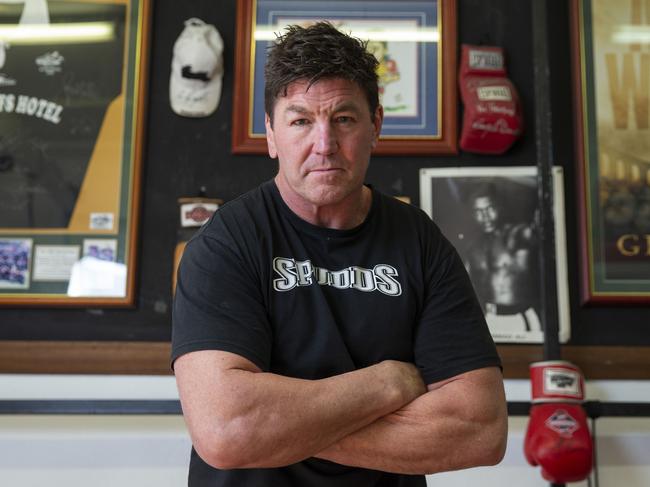NRL 2024 concussion protocols: Spudd Carroll’s urgent warning following Corey Parker CTE revelations
Following NRL legend Corey Parker’s shock CTE revelations, former rugby league hard man Mark Carroll has called on the game’s rule makers to extend concussion protocols urgently.

NRL
Don't miss out on the headlines from NRL. Followed categories will be added to My News.
Former rugby league hard man Mark Carroll has urged the NRL to introduce longer concussion stand down periods in the wake of Brisbane great Corey Parker’s shock CTE revelations.
The NRL brought in an 11-day stand down rule as part of revamped protocols almost 12 months ago for players diagnosed with concussion. But Carroll believes that period should be at least three weeks long.
“The stand down is 11 days. That’s bullshit,” Carroll said.
“If you’re a boxer, it’s at least 30 days if not longer. It used to be 7 days in the NRL, then they went to 11 days because some metrics, determined by a computer, recommended that time frame.
“Longer stand downs will hurt clubs and their rosters but it’s in the best interests of the player.
“It should be at least three weeks, what’s 11 days if a player has been diagnosed with a concussion? It’s not long enough.”
The effects of head knocks and trauma is an issue close to Carroll.
In March last year, the former South Sydney and Manly cult hero revealed a PET scan showed he was suffering from symptoms of CTE.

CTE – chronic traumatic encephalopathy – is a degenerative brain disease associated with repeated subconcussive head knocks and concussions. Now Parker, 41 is worried ‘the damage is done’ revealing that, after playing 347 NRL games, he is experiencing symptoms of CTE.
“This CTE, it’s the word that obviously gets thrown around and rightly so, it is real,” Parker said on SEN.
“I’ve got no doubt, I have no doubt whatsoever over my tenure as a rugby league player that I have symptoms, I have symptoms of CTE. But it’s something that you can’t really get a grasp on until obviously post-mortem. You can try and manage different things, but the damage is done, isn’t it.”
Carroll believes Parker, and any former player, regardless of age, should seek out a brain specialist at the first sign of symptoms.
“My main thing now is, I have been telling anyone that thinks the blokey way is to say ‘nah, I’m OK’ to put the guard down and go and see a neurologist,” Carroll said.
“That’s what I’d say to Corey.
“I did that myself after the Mario Fenech story, and I thought about my mate Peter Johnston, who was one of the biggest hitters in the game. He knocked Mario out a few times. So I went and got a test thinking I would be fine but it came back with concerns.
“Ask for the test. It’s what we are trying to do now, myself and James Graham are close to getting the NRL on board to help past players.”
Concussion, and the risk associated with head knocks, is one of the biggest issues collision sports currently face with lawsuits ongoing abroad and at home, where the AFL is fighting a major class action by 100 players.
Despite his own fears over CTE, Parker said the NRL was in “a good spot” but conceded it was hard to avoid the impact of playing such a physical sport.
“The game has some accountability to take from an NRL point of view. I think they’re in a really good space at the moment, particularly on a junior level,” Parker said.
“From a senior level, I think at the moment the game has been in a really good spot. You can’t expect to play a high-collision sport for 20 of those years at a high level and not have some sort of side effects.

“There were points in my career where I knew I was concussed, I knew I was dazed and towards the back-end of my career, I would actually buy myself time on the ground and grab a shoulder or leg until my head was right to then get to my feet. I knew if I got to my feet I’d stumble, which is definitely not the right way to be thinking.”
Players feigning injury to avoid being taken off the field for a head knock is now harder than ever.
In 2022, the NRL introduced independent doctors in the bunker that had the power to remove players for head injury assessments, and rule them out of matches, if the player displayed any concussion symptoms.
Rugby league legend Wally Lewis spoke about his own struggles this week at a Dementia Australia panel at Parliament House calling for federal government fund education programs at grassroots level.
“We need to teach the players from the grassroots level to play the game more safely and we need to equip the parents and teachers around them with the confidence and information they need to support our kids,” he said.
“It’s the subconcussion risk that needs to change as much as concussion.”
Chronic traumatic encephalopathy is a form of dementia that can only be diagnosed post mortem.
Several former NRL players, including the late North Queensland and Maroons coach Paul Green, were diagnosed after his death in August 2022.




